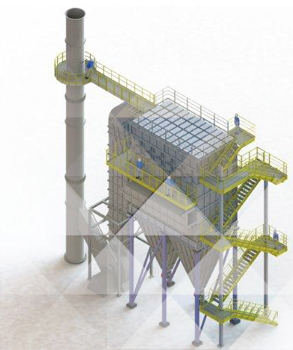Equipments
Bag Filter High Pressure

The simpler (and yet not less effective) version of dry filtration for process gases is the Bag Filter High-Pressure, which is also named after the type of cleaning that it put through. It is used for filtering several types of particulate matter from industrial customer process gases the flow of which is forced by exhaustion, providing a continuous gas filtering operation through the bags.
Our bags, which are critical items for proper operation and efficiency of the equipment, have the appropriate characteristics for each type of process, where variables like temperature and gas composition make the choice of bag type very important, as such variables will also either increase or decrease the total load loss for sizing and specifying the fan that will exhaust gases through pipes and exhaust hoods and into the filter.
With cutting-edge technology from Germany, the bags used in our equipment are manufactured with the finest materials on the market, as well as highly sturdy and easy to maintain. They are manufactured according to each design, which enables specific diameters and several lengths to be used. Also, thanks to advanced manufacturing processes, their cost is no impediment to our filters being financially attractive.
The same goes to our cages, Venturi mills and other fastening items in terms of description, as they are tailored to each design and suitable to each kind of industrial process.
As time goes by, the gas filtration retains particulate matter on the outer surface of the bag, thereby reducing the gas flow area and, as a result, increasing the load loss on the fan. At this point comes the cleaning system which blows compressed air into the system, more specifically inside the bags, causing the agitation required for releasing the particulate matter that it retain.
This air blowing is electronically controlled by a PLC programmed for automatic operation. Such control is provided by valves that are triggered to allow the compressed air, at a certain pressure, to flow into the system through “blow pipes” which drive the air jet to each bag, creating the necessary agitation.
Once the particulate matter is shaken, it is released from the bag surface and falls down to the bottom of the hopper, where it is stored until transportation/packing. Such transportation is also taken into consideration in the designing of the bags, so that a piece of equipment can be built with different hopper arrangements, which will identify the best outflow control type for this material, such as a screw conveyor, for longitudinal hoppers, or just a rotary valve, for pyramidal hoppers. Sets can even be put together with the two of these pieces of equipment, whether or not using a slide valve for enhanced control.
Different standard types of inlets will influence the type of table roll baffle for internal protection of bags and other internal components which are sized so as not to cause any major load loss in the system. For internal maintenance and safety, dampers are used, where required, to control the gas flow in each chamber.
The extensive technology possessed by CRANFOS allows filter designs to be developed more freely for very high gas flow rates, without prejudice to efficiency or any structural problems in our equipment. In special cases, CFD-based simulations are made for providing a preview of the system in load condition.